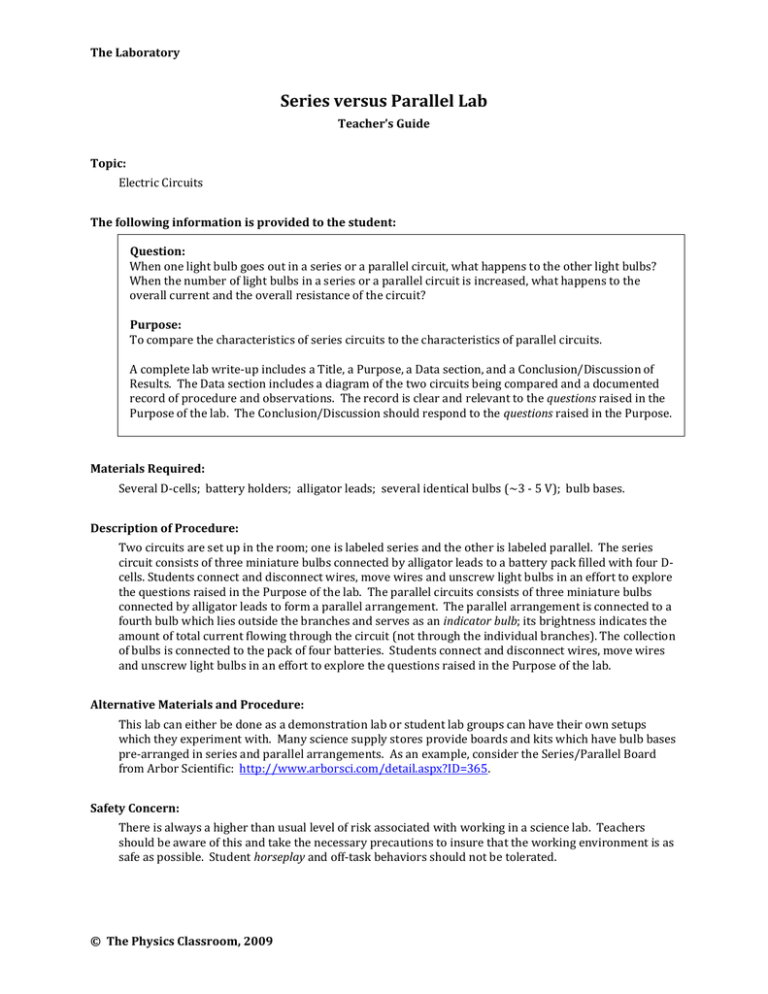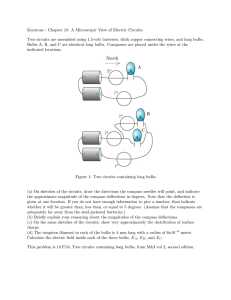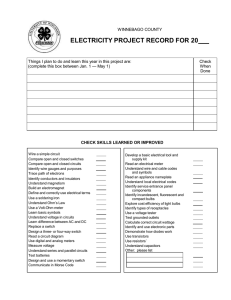Series versus Parallel Lab
advertisement

The Laboratory Series versus Parallel Lab Teacher’s Guide Topic: Electric Circuits The following information is provided to the student: Question: When one light bulb goes out in a series or a parallel circuit, what happens to the other light bulbs? When the number of light bulbs in a series or a parallel circuit is increased, what happens to the overall current and the overall resistance of the circuit? Purpose: To compare the characteristics of series circuits to the characteristics of parallel circuits. A complete lab write-up includes a Title, a Purpose, a Data section, and a Conclusion/Discussion of Results. The Data section includes a diagram of the two circuits being compared and a documented record of procedure and observations. The record is clear and relevant to the questions raised in the Purpose of the lab. The Conclusion/Discussion should respond to the questions raised in the Purpose. Materials Required: Several D-cells; battery holders; alligator leads; several identical bulbs (~3 - 5 V); bulb bases. Description of Procedure: Two circuits are set up in the room; one is labeled series and the other is labeled parallel. The series circuit consists of three miniature bulbs connected by alligator leads to a battery pack filled with four Dcells. Students connect and disconnect wires, move wires and unscrew light bulbs in an effort to explore the questions raised in the Purpose of the lab. The parallel circuits consists of three miniature bulbs connected by alligator leads to form a parallel arrangement. The parallel arrangement is connected to a fourth bulb which lies outside the branches and serves as an indicator bulb; its brightness indicates the amount of total current flowing through the circuit (not through the individual branches). The collection of bulbs is connected to the pack of four batteries. Students connect and disconnect wires, move wires and unscrew light bulbs in an effort to explore the questions raised in the Purpose of the lab. Alternative Materials and Procedure: This lab can either be done as a demonstration lab or student lab groups can have their own setups which they experiment with. Many science supply stores provide boards and kits which have bulb bases pre-arranged in series and parallel arrangements. As an example, consider the Series/Parallel Board from Arbor Scientific: http://www.arborsci.com/detail.aspx?ID=365. Safety Concern: There is always a higher than usual level of risk associated with working in a science lab. Teachers should be aware of this and take the necessary precautions to insure that the working environment is as safe as possible. Student horseplay and off-task behaviors should not be tolerated. © The Physics Classroom, 2009 The Laboratory Suggestions, Precautions, Notes: 1. 2. 3. Allow plenty of time to prepare this lab. The types of bulbs and the number of batteries may have to be experimented with before satisfactory results are achieved. One idea for implementing the lab is to form four student groups and to have two large stations in the lab section of your classroom. Two groups could be sent to the back of the room to conduct their observations - spending approximately 5-10 minutes at each station. Meanwhile, the other two groups remain in the front of the room for a short mini-lesson or a practice session. After 1520 minutes, the set of two groups trade places. Once both groups have made their observations, a post-lab session could be conducted. In the post-lab session, take the time to impress upon the students the remarkable nature of the observations made of parallel circuits: as the number of resistors increases, the overall resistance decreases. The idea of adding more resistors causes more resistance should bother many students. Emphasize that not only has a new resistor been added, but a new pathway has been added as well. A toll way analogy often helps students resolve this discrepant event. The analogy is discussed in The Physics Classroom Tutorial: http://www.physicsclassroom.com/Class/circuits/u9l4b.cfm#p9. Auxiliary Materials: None Scoring Rubric: C6. Series vs. Parallel Lab Included, labeled and organized all parts of the lab report. Data section includes a diagram of the series and the parallel circuit; tests which were conducted are documented; results are clearly recorded. Conclusion/Discussion answers all the questions posed in the Purpose; answers are correct, clearly stated and complete. Connections to The Physics Classroom Tutorial: The following reading is a suitable accompaniment to this lab: http://www.physicsclassroom.com/Class/circuits/u9l4b.cfm Connections to Minds on Physics Internet Modules: Sublevels 7 and 8 of the Electric Circuits module are suitable accompaniments to this lab: http://www.physicsclassroom.com/mop/module.cfm © The Physics Classroom, 2009 Score _____/_____








